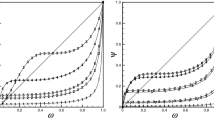Abstract
First this paper analyzes the reason for the accuracy losing of the third-order weighted essentially non-oscillatory (WENO) scheme. It is shown that one reason is that the local smoothness indicators of the third-order WENO scheme cannot correctly treat the smooth three-point stencil containing a non-nodal critical point, here, ‘non-nodal’ means the critical point is not a grid point. And then a discontinuity-detecting method for a four-point stencil is proposed and applied to develop the high order accurate hybrid-WENO scheme by combining the third-order WENO scheme and a third-order upstream scheme. This four-point stencil is actually the stencil used for constructing the third-order WENO scheme (positive and negative numerical fluxes), hence the resulting hybrid-WENO scheme proposed by this paper does not introduce new grid point. Numerical examples show that the detecting method and the hybrid scheme are robust for problems with shocks, and the hybrid scheme obtains real third-order convergence rate for smooth solutions containing critical points.



























Similar content being viewed by others
References
Liu, X.D., Osher, S., Chan, T.: Weighted essentially non-oscillatory schemes. J. Comput. Phys. 115, 200–212 (1994)
Harten, A., Engquist, B., Osher, S., Chakravarthy, S.: Uniformly high order essentially non-oscillatory schemes III. J. Comput. Phys. 71, 231–303 (1987)
Jiang, G.S., Shu, C.W.: Efficient implementation of weighted ENO schemes. J. Comput. Phys. 126, 202–228 (1996)
Balsara, D.S., Shu, C.W.: Monotonicity preserving weighted essentially non-oscillatory schemes with increasingly high order of accuracy. J. Comput. Phys. 160, 405–452 (2000)
Gerolymos, G., Senechal, D., Vallet, I.: Very-high-order WENO schemes. J. Comput. Phys. 228, 8481–8524 (2009)
Liu, S., Shen, Y., Chen, B., Zeng, F.: Novel local smoothness indicators for improving the third-order WENO scheme. Int. J. Numer. Methods Fluids 87, 51–69 (2018)
Yamaleev, N.K., Carpenter, M.H.: Third-order energy stable WENO scheme. J. Comput. Phys. 228, 3025–3047 (2009)
Wu, X., Zhao, Y.: A high-resolution hybrid scheme for hyperbolic conservation laws. Int. J. Numer. Methods Fluids 78, 162–187 (2015)
Wu, X., Lian, J., Zhao, Y.: A new smoothness indicator for third-order WENO scheme. Int. J. Numer. Methods Fluids 81, 451–459 (2016)
Gande, N.R., Rathod, Y., Rathan, S.: Third-order WENO scheme with a new smoothness indicator. Int. J. Numer. Methods Fluids 85, 90–112 (2017)
Xu, W., Wu, W.: An improved third-order weighted essentially non-oscillatory scheme achieving optimal order near critical points. Comput. Fluids 162, 113–125 (2018)
Xu, W., Wu, W.: An improved third-order WENO-Z scheme. J. Sci. Comput. 75, 1808–1841 (2018)
Acker, F., de Borges, R.B.R., Costa, B.: An improved WENO-Z scheme. J. Comput. Phys. 313, 726–753 (2016)
Henrick, A.K., Aslam, T.D., Powers, J.M.: Mapped weighted essentially non-oscillatory schemes: achieving optimal order near critical points. J. Comput. Phys. 207, 542–567 (2005)
Shen, Y., Zha, G.: Generalized finite compact difference scheme for shock/complex flowfield interaction. J. Comput. Phys. 230, 4419–4436 (2011)
Shu, C.W., Osher, S.: Efficient implementation of essentially non-oscillatory shock-capturing schemes. J. Comput. Phys. 77, 439–471 (1988)
Szirtes, T., Rozsa, P.: Applied dimensional analysis and modeling (second edition). Appl. Dimens. Anal. Model. 25, 99–132 (2007)
Najiafi-Yazdi, A., Mongeau, L.: A low-dispersion and low-dissipation implicit Runge–Kutta scheme. J. Comput. Phys. 233, 315–323 (2013)
Shu, C.W.: Essentially non-oscillatory and weighted essentially non-oscillatory schemes for hyperbolic conservation laws. ICASE Report 97–65 (1997)
Borges, R., Carmona, M., Costa, B., Don, W.S.: An improved weighted essentially non-oscillatory scheme for hyperbolic conservation laws. J. Comput. Phys. 227, 3191–3211 (2008)
Roe, P.L.: Approximate Riemann solvers, parameter vectors, and difference schemes. J. Comput. Phys. 43, 357–372 (1981)
Sun, Y.Z., Wang, Z.: Evaluation of discontinuous Galerkin and spectral volume methods for scalar and system conservation laws on unstructured grids. Int. J. Numer. Methods Fluids 45, 819–838 (2004)
Davoudzadeh, F., McDonald, H., Thopson, B.: Accuracy evaluation of unsteady CFD numerical schemes by vortex preservation. Comput. Fluids 24, 883–895 (1995)
Kurganov, A., Tadmor, E.: Solution of two-dimensional Riemann problems for gas dynamics without Riemann problem solvers. Numer. Methods Partial Differ. Equ. 18, 584–608 (2002)
Shen, Y.Q., Yang, G.W.: Hybrid finite compact-WENO schemes for shock calculation. Int. J. Numer. Methods Fluids 53, 531–560 (2007)
Acknowledgements
This research work was supported by the NKRDPC 2016YFA0401200, SCP No. TZ2016002, NSAF U1530145, NSFC Nos. 11872067 and 91852203.
Author information
Authors and Affiliations
Corresponding author
Additional information
Publisher's Note
Springer Nature remains neutral with regard to jurisdictional claims in published maps and institutional affiliations.
This research work was supported by the NKRDPC 2016YFA0401200, SCP No. TZ2016002, NSAF U1530145, NSFC Nos. 11872067 and 91852203.
Rights and permissions
About this article
Cite this article
Liu, S., Shen, Y. Discontinuity-Detecting Method for a Four-Point Stencil and Its Application to Develop a Third-Order Hybrid-WENO Scheme. J Sci Comput 81, 1732–1766 (2019). https://doi.org/10.1007/s10915-019-01060-8
Received:
Revised:
Accepted:
Published:
Issue Date:
DOI: https://doi.org/10.1007/s10915-019-01060-8




